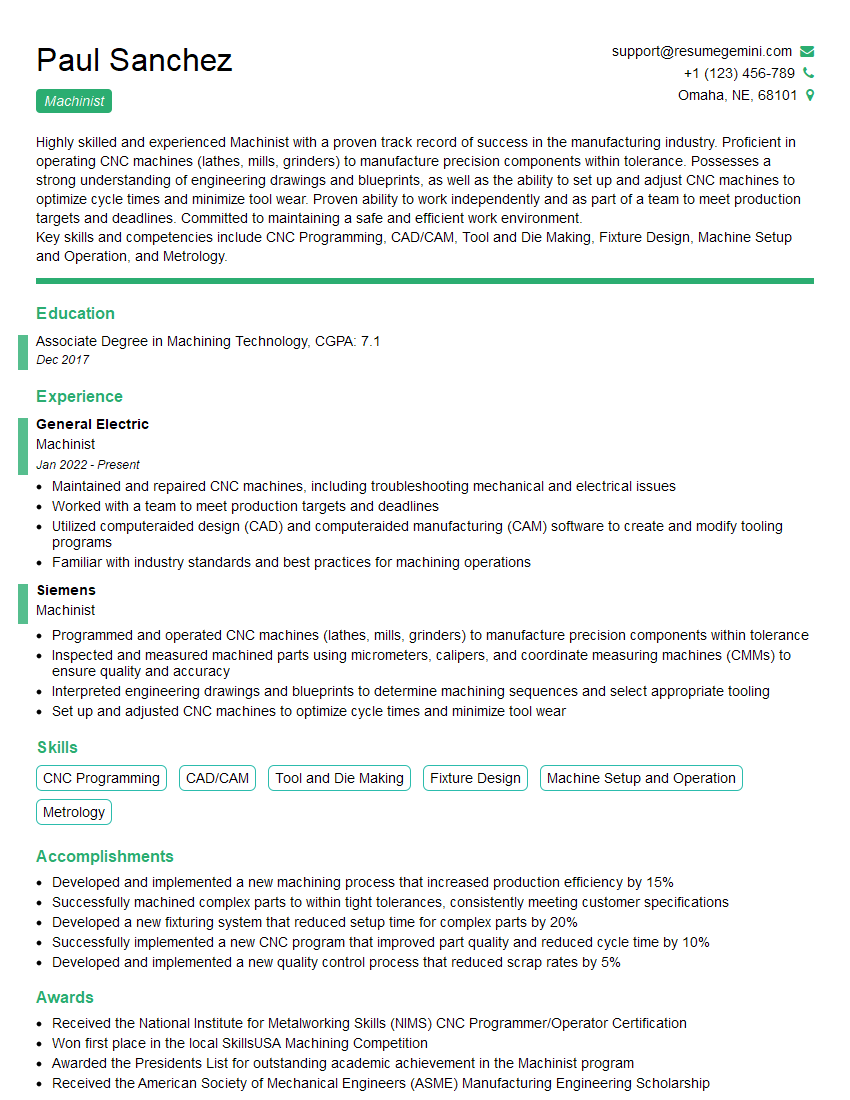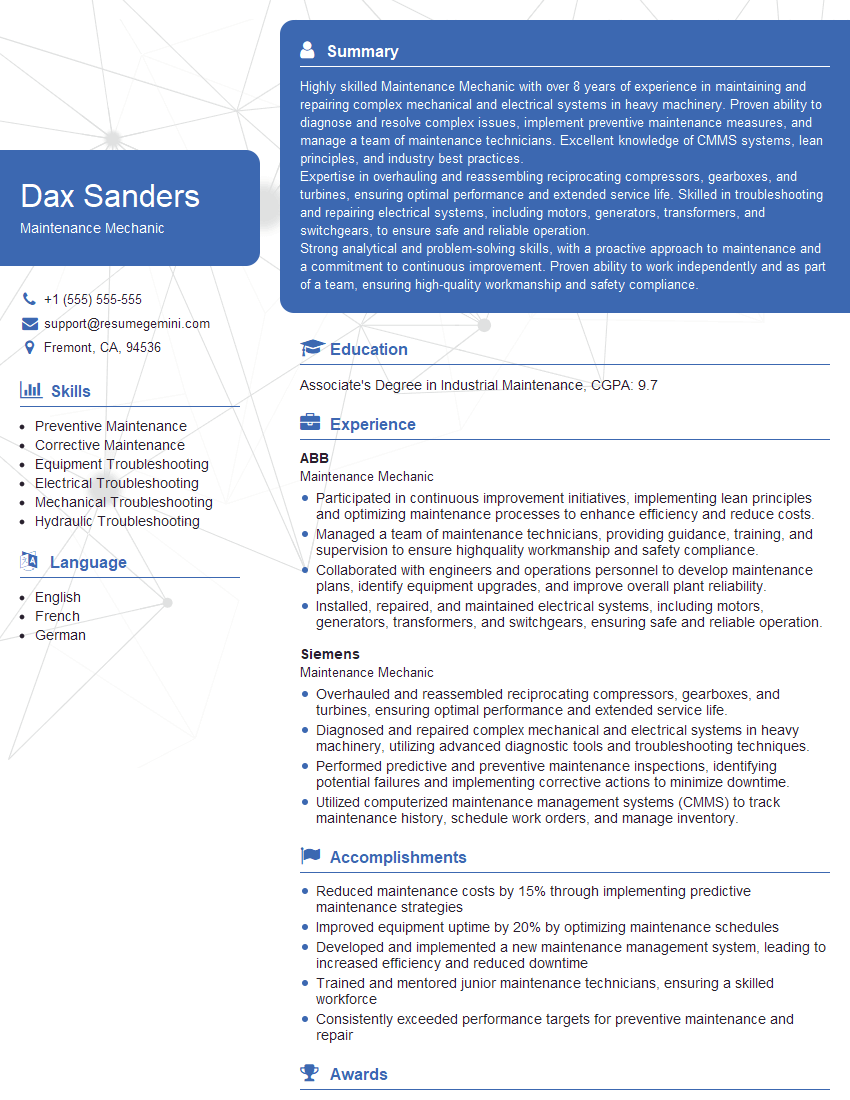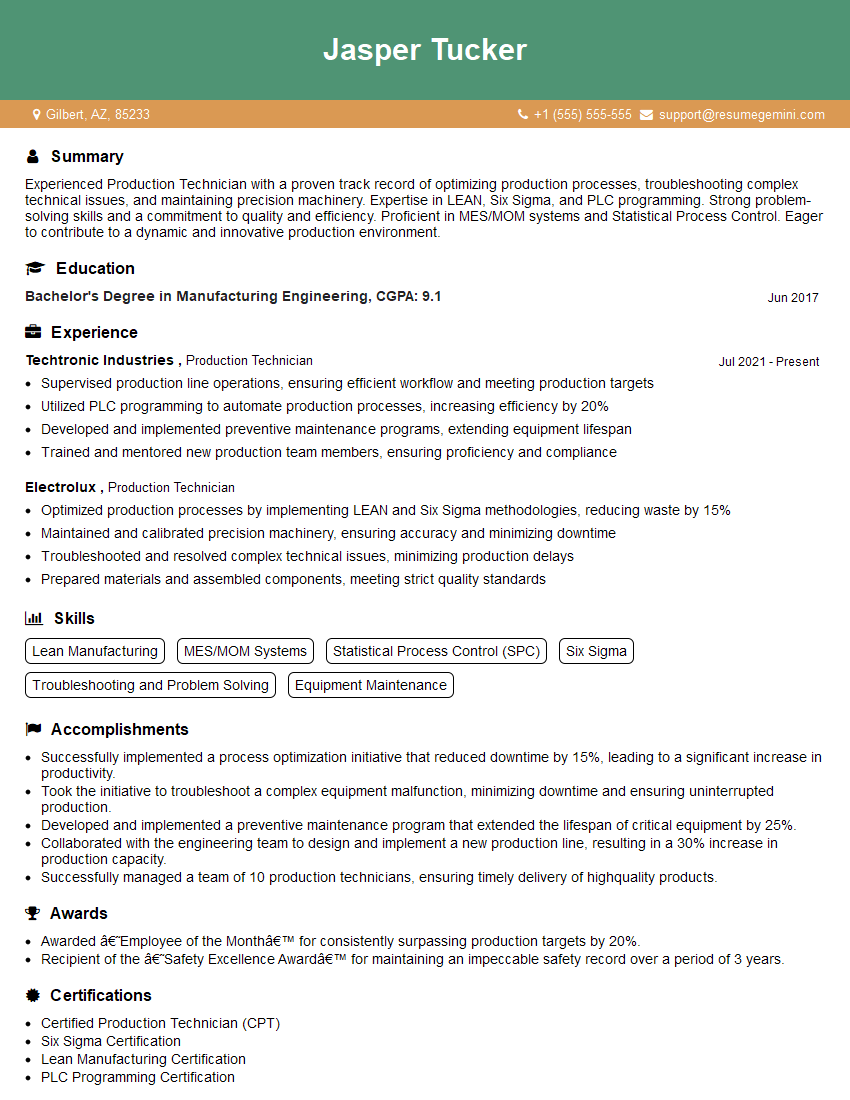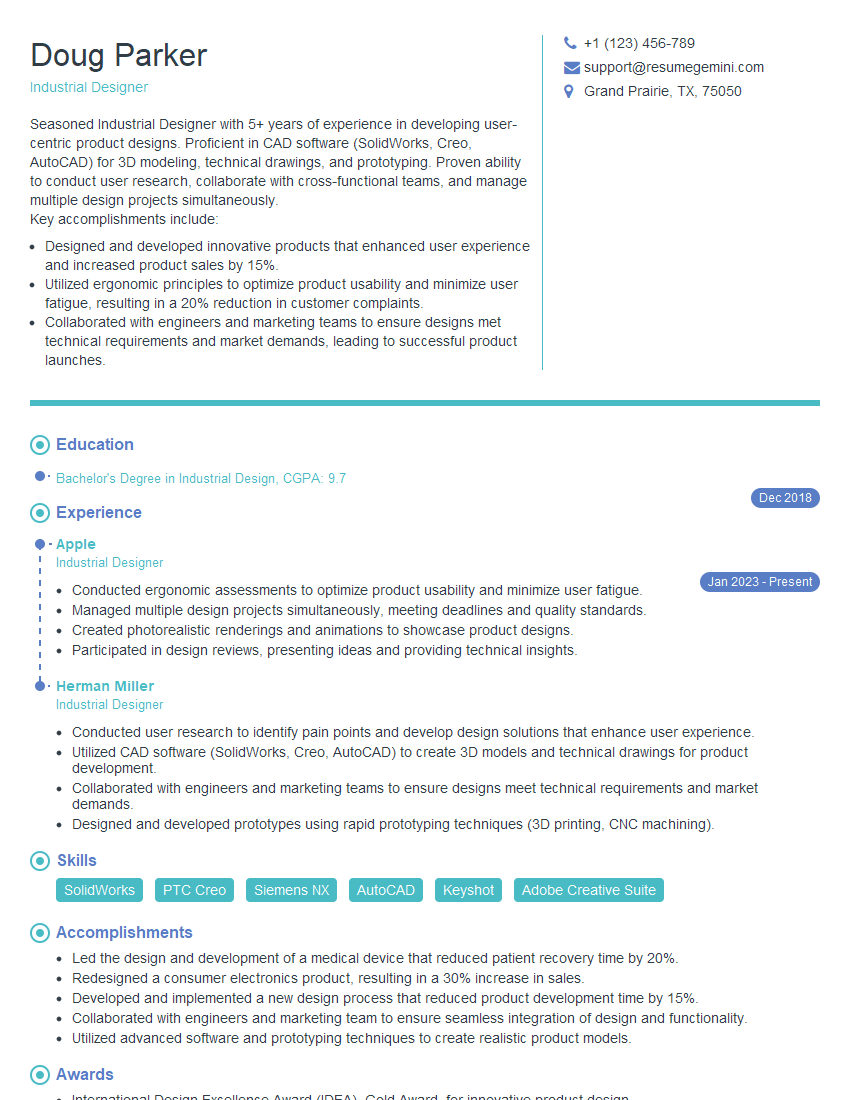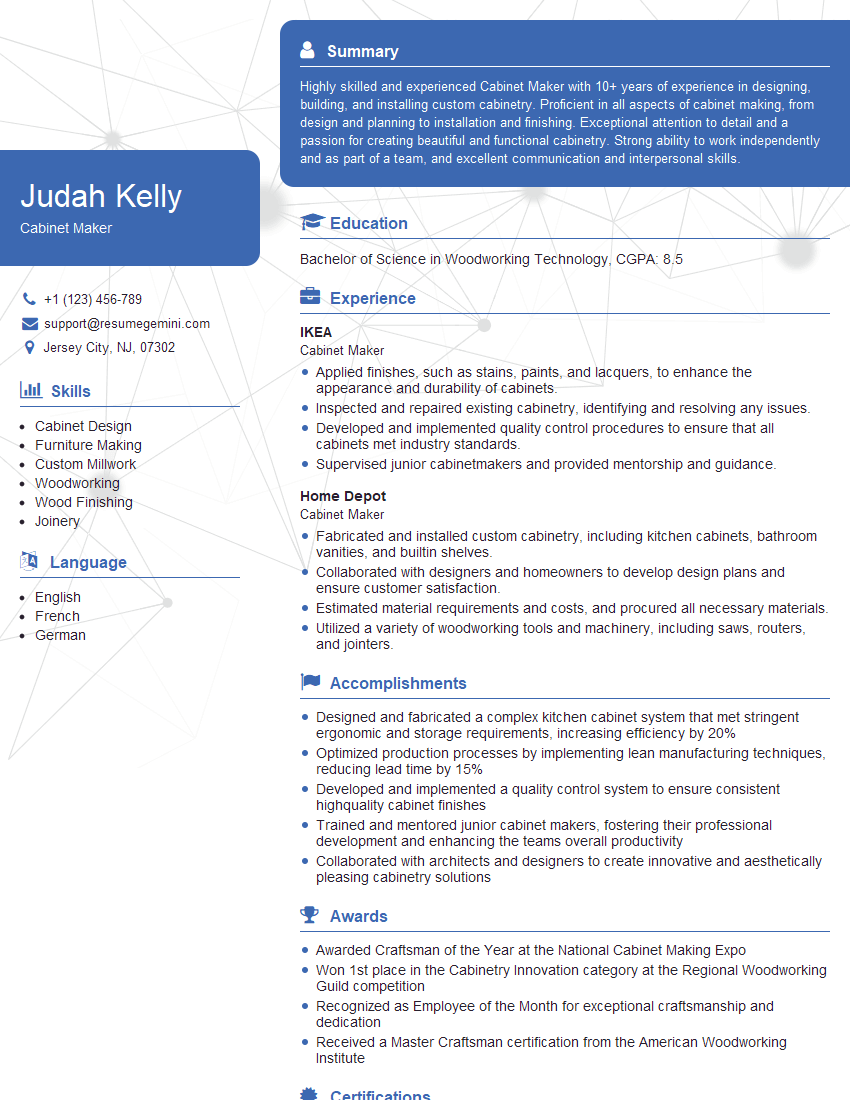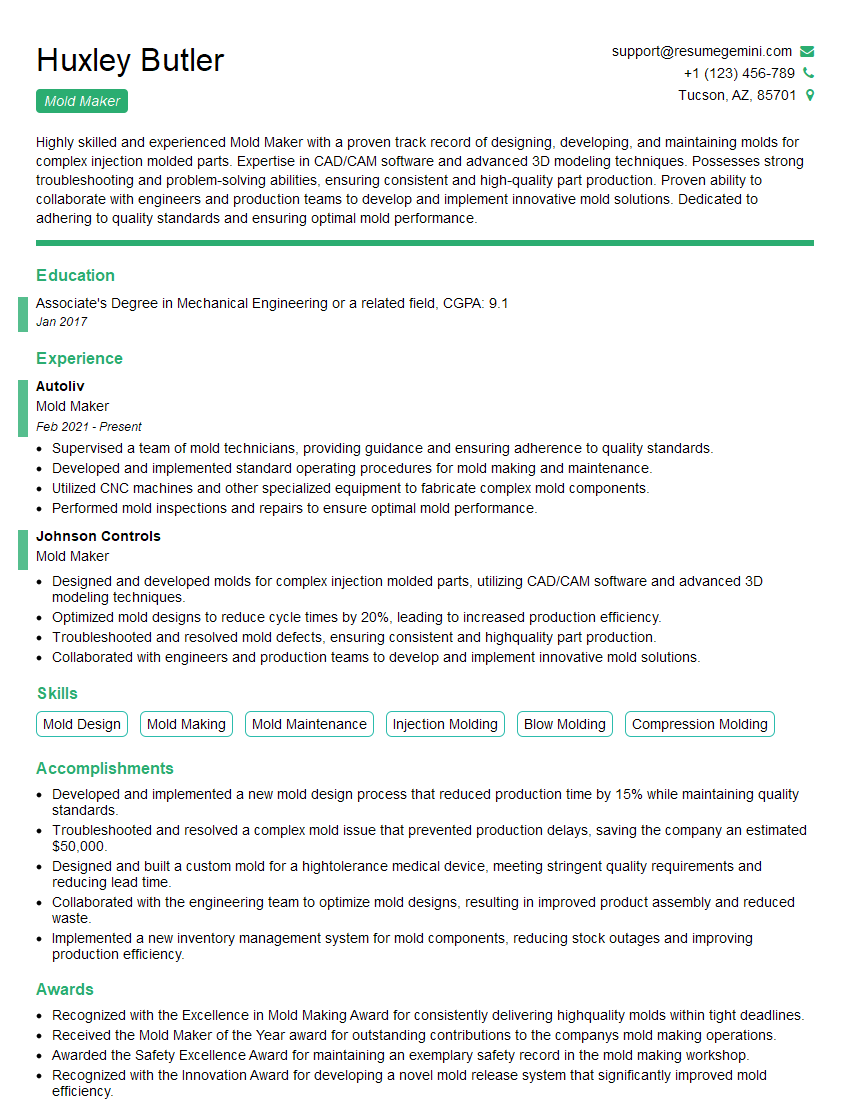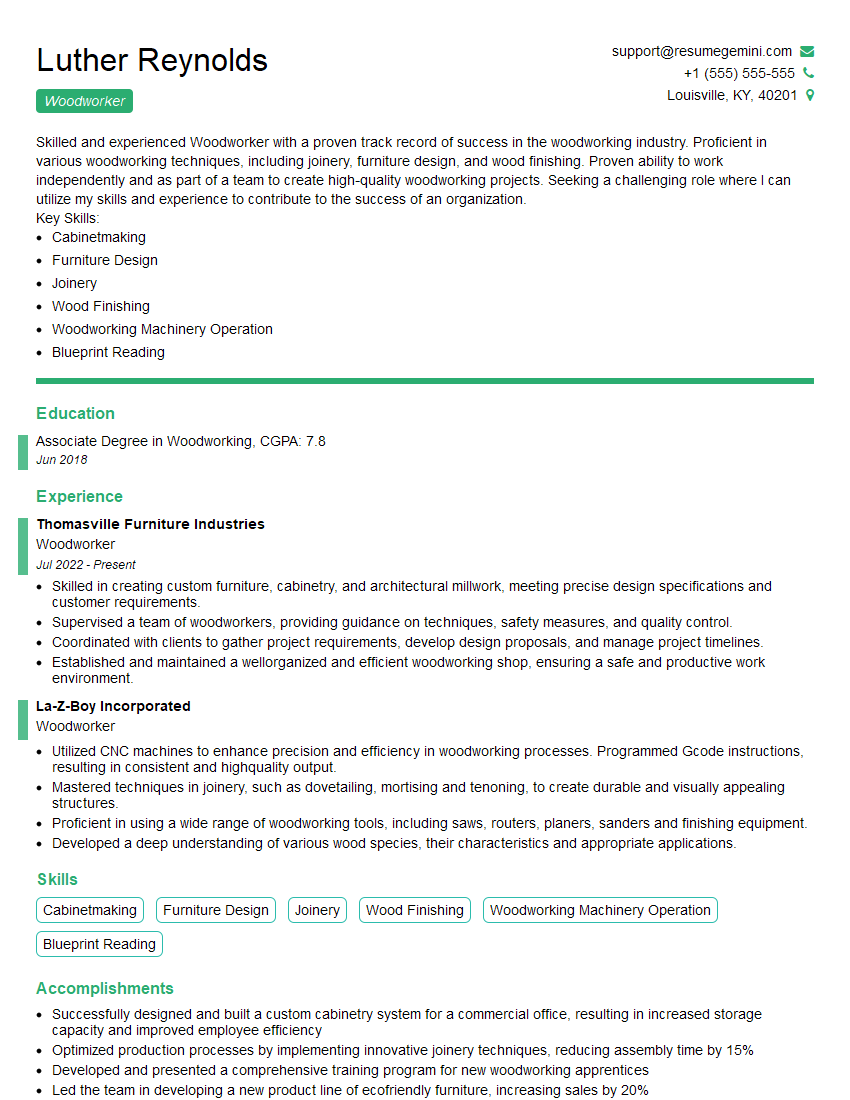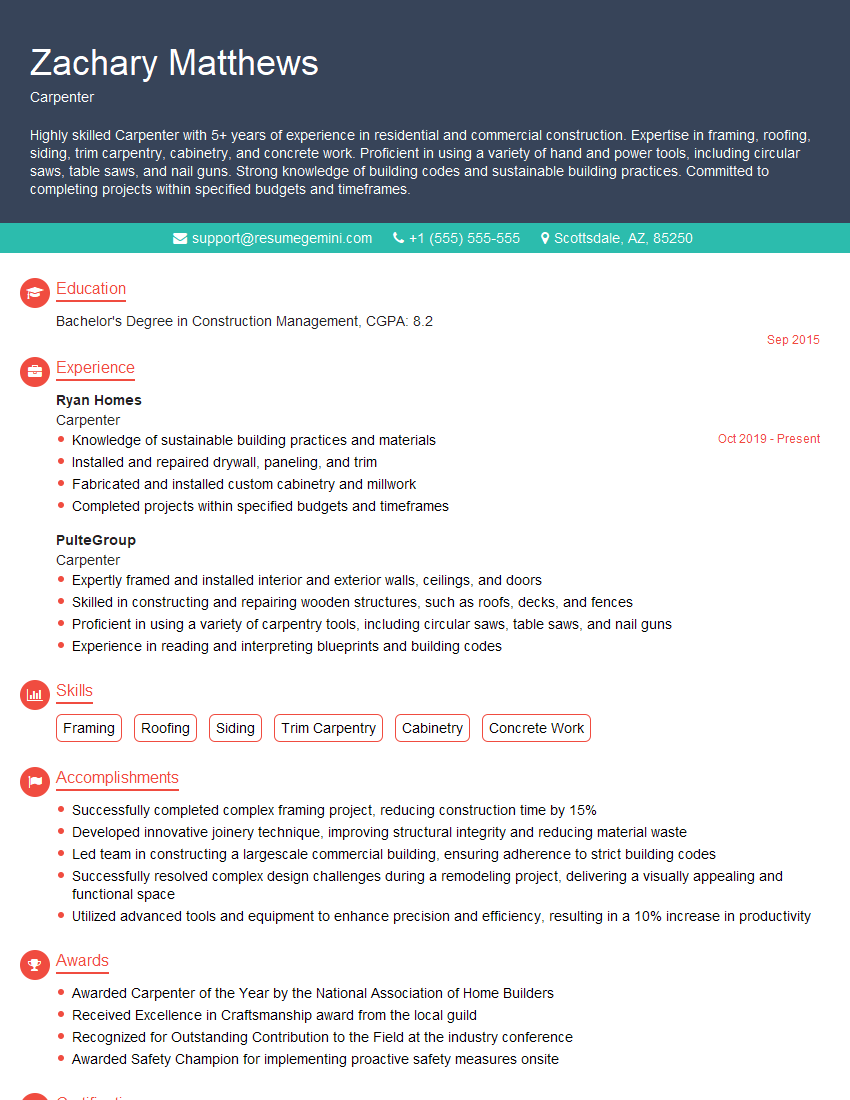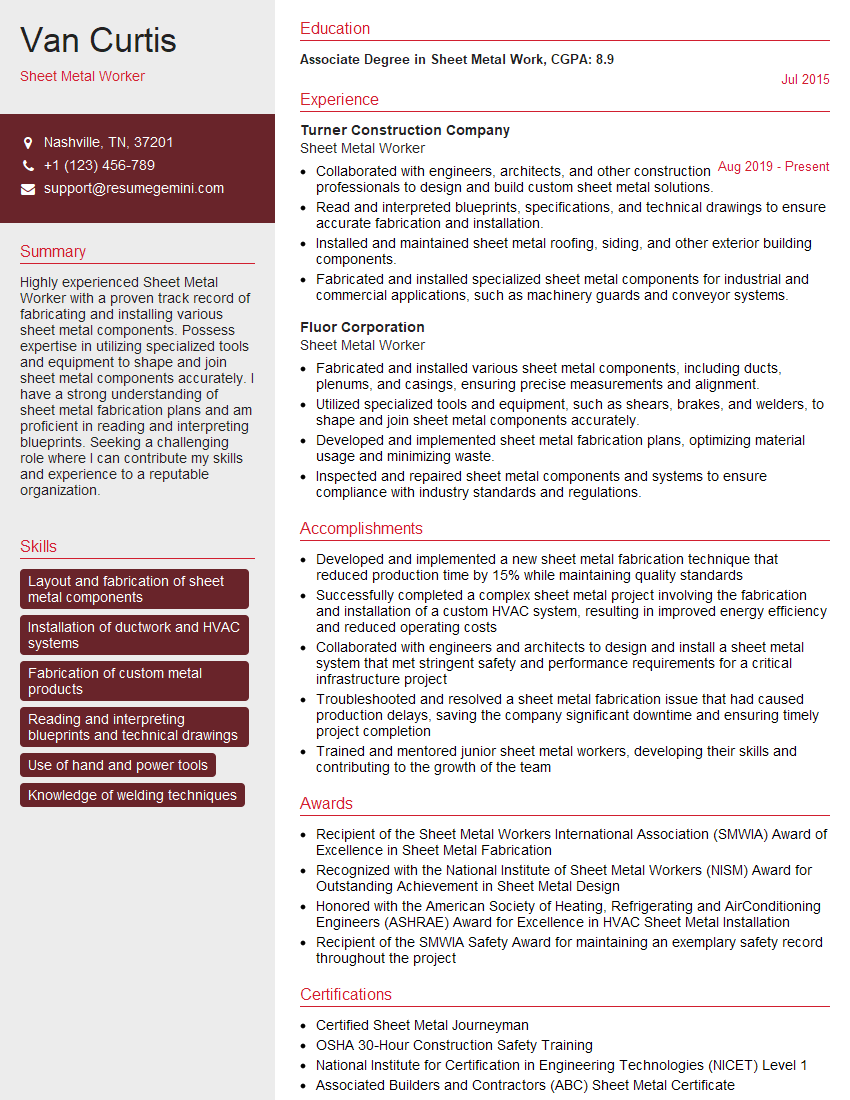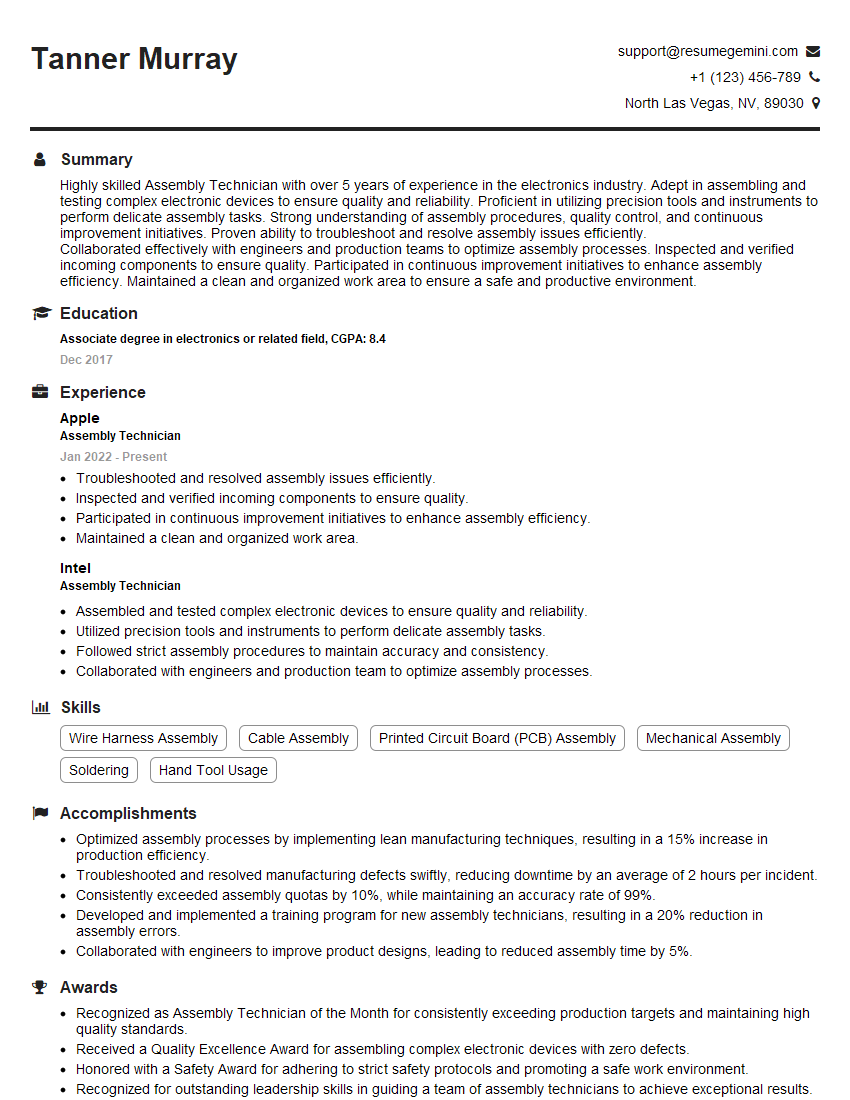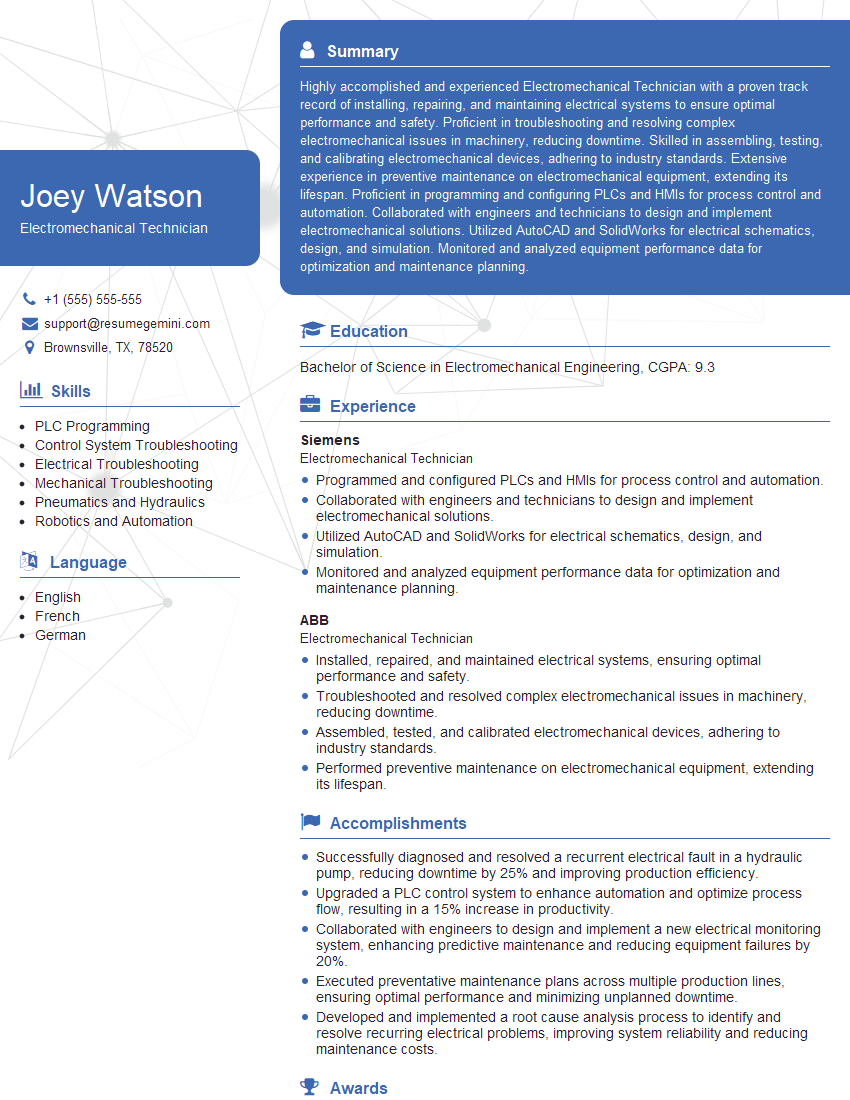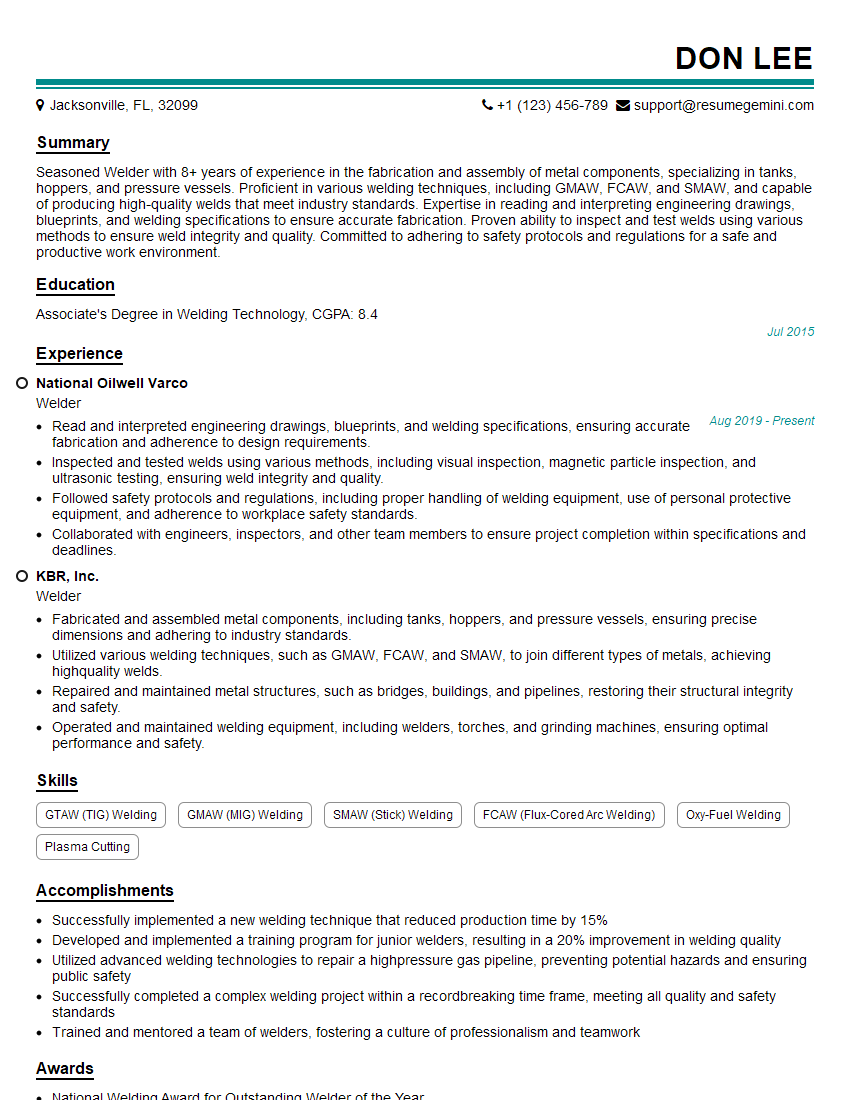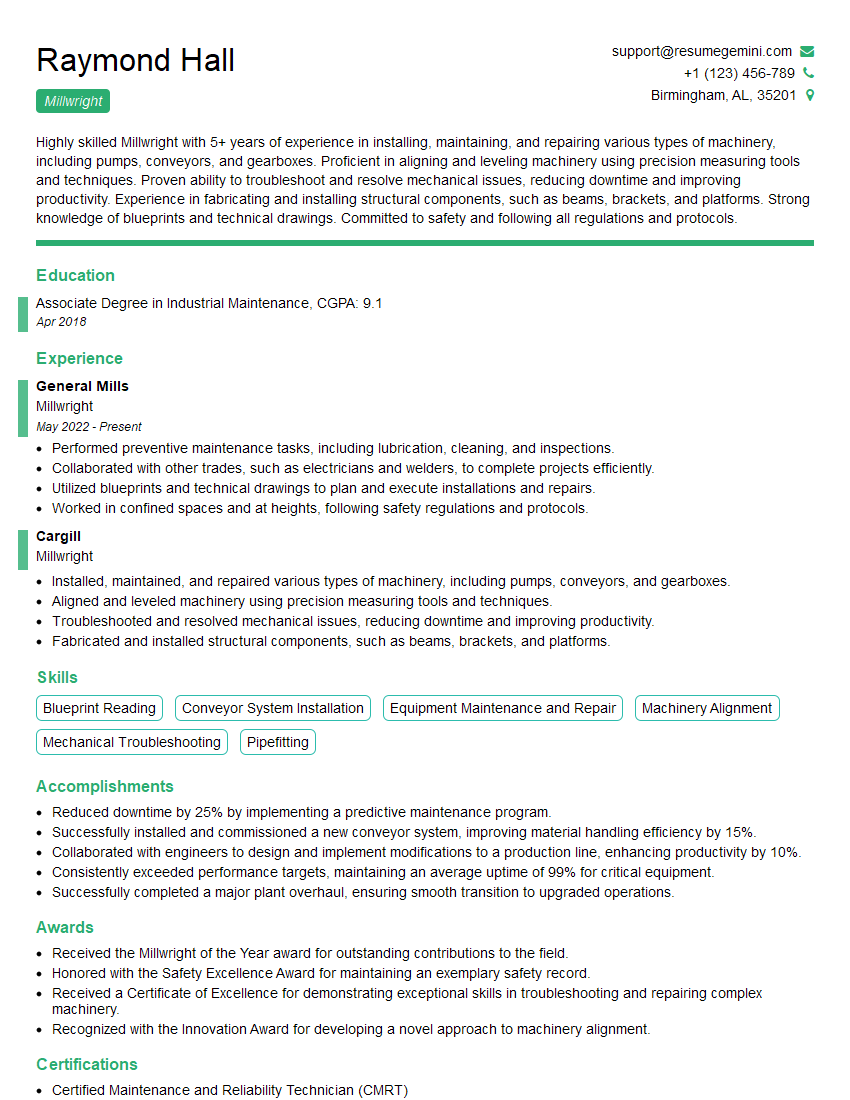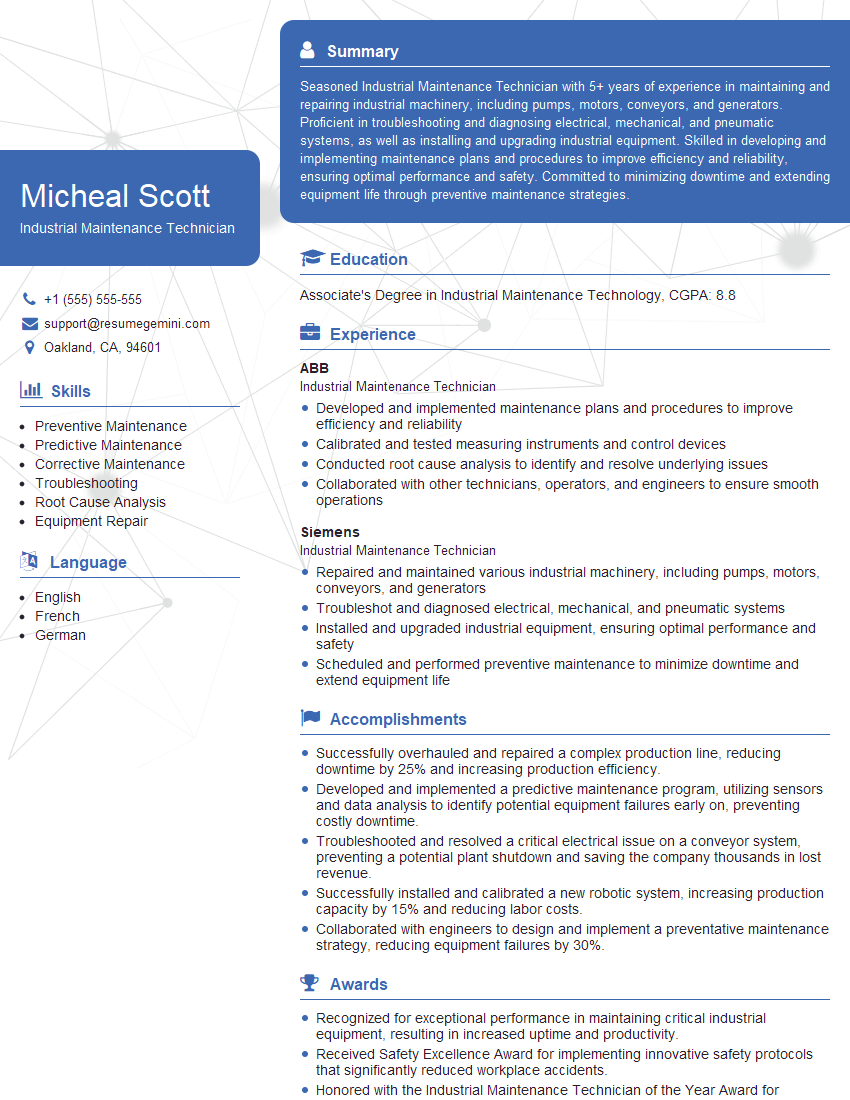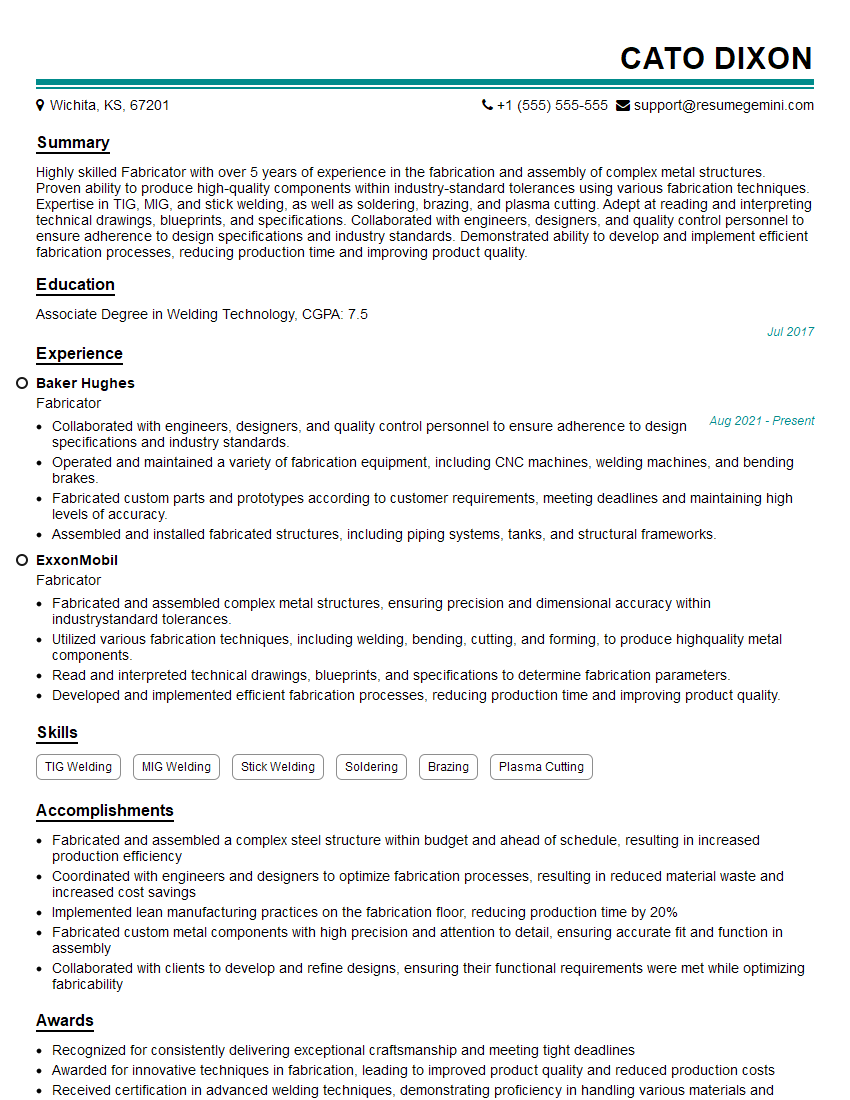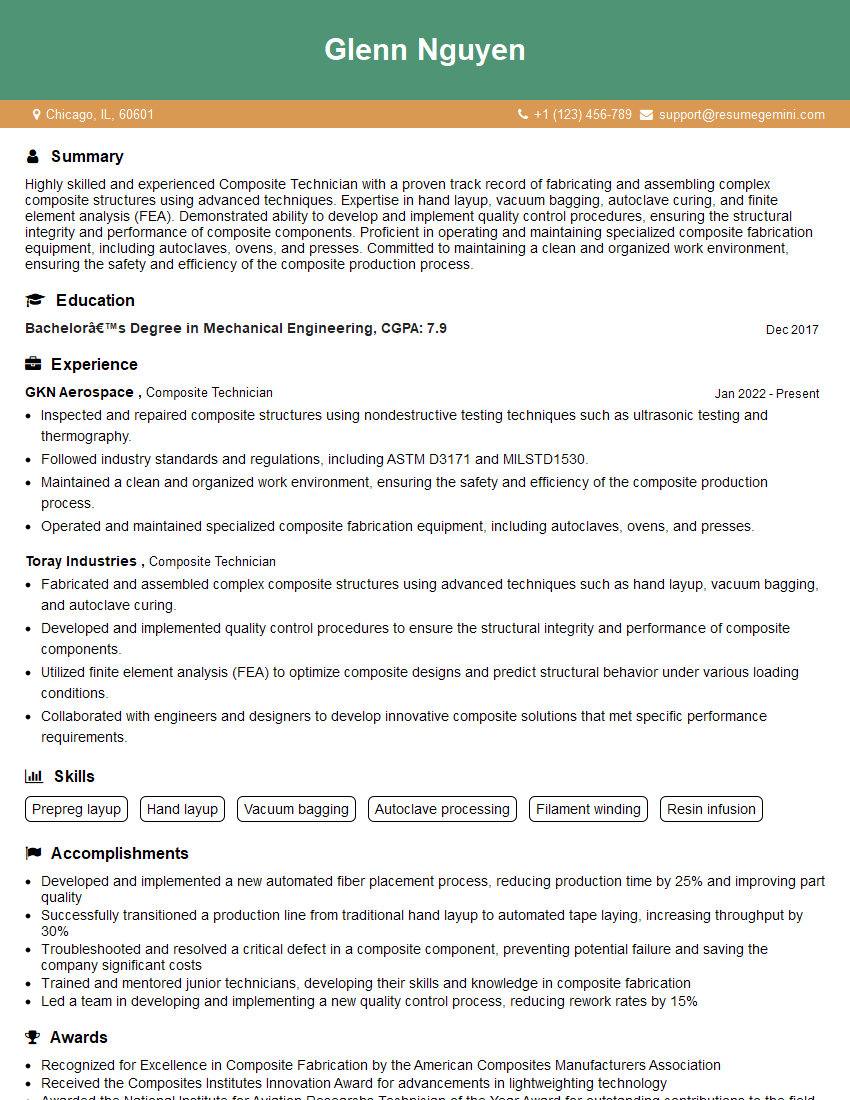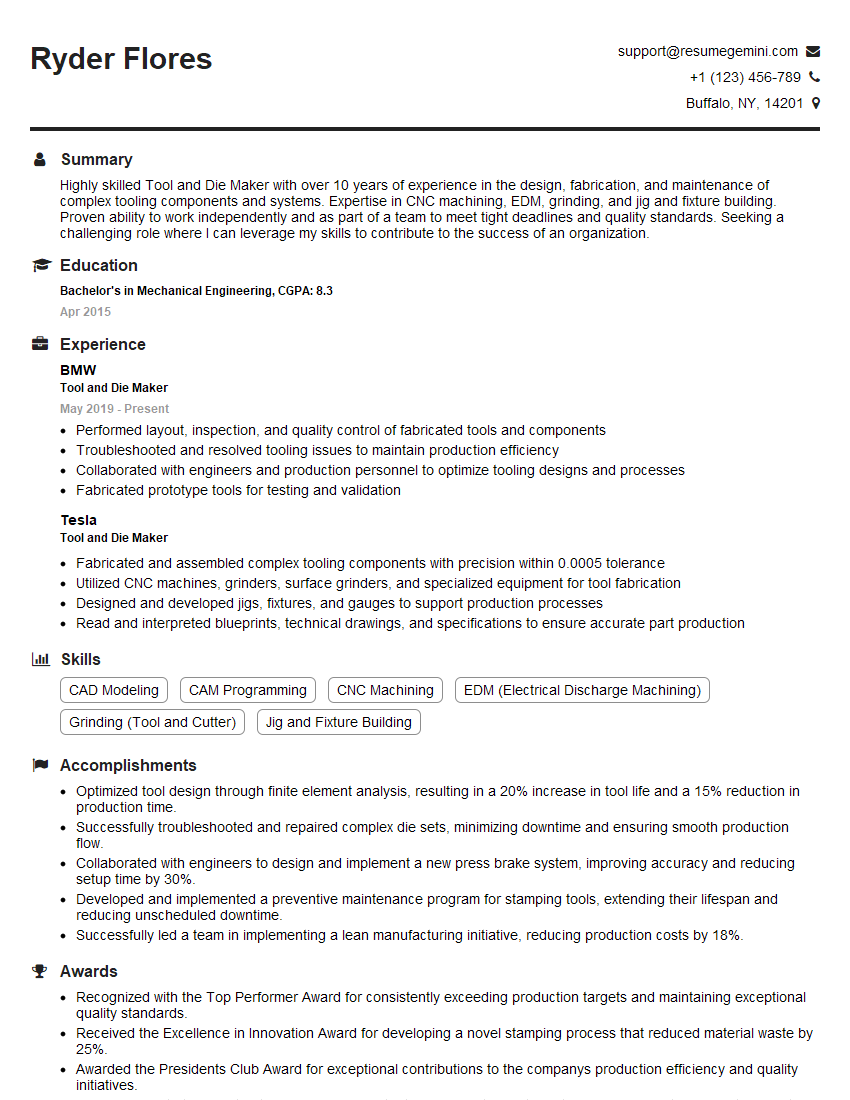Interviews are more than just a Q&A session—they’re a chance to prove your worth. This blog dives into essential Ability to work with a variety of materials, including wood, metal, and plastic interview questions and expert tips to help you align your answers with what hiring managers are looking for. Start preparing to shine!
Questions Asked in Ability to work with a variety of materials, including wood, metal, and plastic Interview
Q 1. Describe your experience working with different types of wood.
My experience with wood spans a wide range of species and applications. I’m proficient in working with hardwoods like oak, maple, and cherry, appreciating their strength and beautiful grain patterns, ideal for furniture making and fine woodworking. Softer woods like pine and poplar are also frequently used, particularly in projects requiring ease of carving or where a more affordable material is needed. I understand the importance of selecting the right wood for the job, considering factors like its density, grain direction, and susceptibility to warping or cracking. For example, when building a sturdy table, I’d opt for a strong hardwood like oak; for a detailed carving, a softer wood like basswood would be preferable. I’m familiar with various wood treatments, from simple sanding and finishing to more complex techniques like steam bending and joinery. I’ve worked extensively with both rough-sawn lumber and kiln-dried stock, understanding how moisture content affects the final product.
- Hardwoods: Oak, Maple, Cherry (strength, durability, beauty)
- Softwoods: Pine, Poplar, Basswood (workability, affordability)
- Techniques: Steam bending, joinery (mortise and tenon, dovetail), finishing (staining, varnishing)
Q 2. What are the common methods for joining metal components?
Joining metal components requires careful consideration of the materials’ properties and the desired strength of the joint. Common methods include:
- Welding: This creates a permanent bond by melting and fusing the metals together. Different welding techniques exist, such as arc welding, MIG welding (Metal Inert Gas), and TIG welding (Tungsten Inert Gas), each suited to different materials and applications. For instance, TIG welding offers greater precision for thinner materials.
- Bolting/Screwing: These are mechanical fastening methods, offering the advantage of easy disassembly. The choice of bolt or screw depends on the materials involved, the required strength, and accessibility. Using appropriate washers is crucial to prevent damage to the metal surfaces.
- Riveting: A permanent mechanical fastening method, suitable for joining sheets or plates. Rivets are deformed to create a strong, shear-resistant connection.
- Soldering/Brazing: These methods use a filler metal with a lower melting point than the base metals, creating a strong bond through capillary action. Soldering is typically used for lower-temperature applications, while brazing is used for higher temperatures and stronger joints.
Selecting the right method depends on factors like the desired strength, the type of metals involved, the need for disassembly, and the aesthetic requirements of the project. For example, welding might be preferred for a strong, permanent structural connection, whereas bolting would be suitable for easily detachable components.
Q 3. Explain your understanding of different plastic types and their properties.
Plastics encompass a vast array of materials with diverse properties. My understanding includes categories such as:
- Thermoplastics: These can be repeatedly melted and reshaped without significant degradation. Examples include polyethylene (PE), polypropylene (PP), polyvinyl chloride (PVC), and acrylonitrile butadiene styrene (ABS). PE is known for its flexibility and chemical resistance, often used in packaging. ABS is a stronger, more rigid material used in many consumer products.
- Thermosets: These undergo an irreversible chemical change during curing, forming a rigid structure. Once cured, they cannot be remelted. Examples include epoxy resins and polyester resins, often used for composites and castings. Epoxy resins are strong and resistant to chemicals.
- Engineering Plastics: These offer high strength, stiffness, and temperature resistance, making them suitable for demanding applications. Examples include polycarbonate (PC), polyetheretherketone (PEEK), and polyamide (nylon). PEEK is known for its exceptional chemical resistance and high-temperature capability.
Each plastic type exhibits unique characteristics in terms of strength, flexibility, temperature resistance, chemical resistance, and processability. Choosing the right plastic involves carefully considering the specific requirements of the application.
Q 4. How would you select the appropriate material for a specific application?
Selecting the appropriate material is a critical step in any design process. It involves considering various factors:
- Functional Requirements: What is the intended use of the component? Does it need to be strong, flexible, lightweight, heat-resistant, or chemically resistant?
- Environmental Conditions: Will the component be exposed to harsh weather, chemicals, or extreme temperatures? The material must be able to withstand these conditions.
- Manufacturing Process: What manufacturing methods will be used? The material must be compatible with the chosen processes (e.g., injection molding, machining, casting).
- Cost: Material costs vary widely. Balancing performance requirements with cost is essential.
- Sustainability: Environmental impact is increasingly important. Consider the material’s recyclability and overall carbon footprint.
For example, designing a lightweight, impact-resistant housing for an electronic device might lead to selecting a thermoplastic like ABS. On the other hand, a high-temperature component for an engine might necessitate using an engineering plastic such as PEEK.
Q 5. Describe your experience with CNC machining.
I have extensive experience operating and programming CNC (Computer Numerical Control) machines, including mills and lathes. I’m proficient in using CAD/CAM software to design and generate CNC programs, ensuring accurate and efficient machining. I can create complex geometries, precisely control tolerances, and generate efficient toolpaths. My experience includes working with various materials, from wood and plastics to aluminum and steel. I understand the importance of proper tool selection, feed rates, and spindle speeds to optimize machining efficiency and surface finish. I’m adept at troubleshooting machine malfunctions, making adjustments to cutting parameters as needed, and ensuring the production of high-quality parts. A recent project involved CNC milling a complex wooden mold for a custom-designed chair. The intricacy of the design required precise programming and careful monitoring throughout the machining process to achieve the required level of accuracy.
Q 6. What safety precautions do you take when working with metal?
Safety is paramount when working with metal. My safety practices include:
- Proper Eye Protection: Always wear safety glasses or a face shield to protect against flying debris or sparks.
- Hearing Protection: Loud noises from machinery require hearing protection such as earplugs or earmuffs.
- Hand Protection: Gloves are essential to protect hands from cuts, burns, and chemical exposure.
- Respiratory Protection: A respirator might be necessary when working with materials that produce dust or fumes.
- Appropriate Clothing: Wear close-fitting clothing to avoid getting it caught in machinery.
- Machine Safety: Ensure that all machinery is properly maintained and that safety guards are in place and functional before operation.
- Proper Lifting Techniques: Use proper lifting techniques to avoid injuries when handling heavy metal pieces.
I always follow the manufacturer’s safety guidelines for any machinery I use and adhere to all relevant workplace safety regulations.
Q 7. How do you handle material waste and disposal?
Material waste management is a crucial aspect of responsible manufacturing. My approach involves:
- Minimizing Waste: Careful planning and efficient machining techniques help minimize material waste. I optimize cutting patterns and utilize scrap material wherever possible.
- Recycling: I diligently separate recyclable materials like metals and plastics for proper disposal. This often involves sorting materials into different bins according to their type (aluminum, steel, different plastic types).
- Proper Disposal: Non-recyclable materials are disposed of according to local regulations and safety guidelines. This might include using designated containers for hazardous waste, if applicable.
- Waste Audits: Periodic waste audits help identify areas for improvement in waste reduction strategies.
I’m committed to environmentally sound practices and strive to reduce waste throughout the entire production process.
Q 8. What experience do you have with welding techniques?
My welding experience encompasses a range of techniques, primarily MIG (Metal Inert Gas), TIG (Tungsten Inert Gas), and stick welding. I’m proficient in both ferrous and non-ferrous metal welding, including steel, aluminum, and stainless steel. MIG welding is my go-to for quick, efficient joins on thicker materials, while TIG welding allows for precise control and aesthetically pleasing welds on thinner materials and intricate designs. Stick welding is my choice for outdoor projects or situations where access to electricity is limited. For example, I recently used TIG welding to create a custom stainless steel bracket for a high-precision instrument requiring a flawless, leak-proof seal. The project demanded meticulous attention to detail and a deep understanding of heat control to avoid warping the delicate bracket.
I’m also experienced in various welding positions, including flat, horizontal, vertical, and overhead, adapting my technique to the specific geometry and material properties of each project.
Q 9. Describe your experience with different types of adhesives.
My experience with adhesives spans a broad spectrum of chemistries and applications. I’m familiar with epoxies, cyanoacrylates (super glues), polyurethanes, acrylics, and silicones, each with its unique properties and suitability for different materials and applications. Epoxies, for instance, are excellent for strong, structural bonds and are often used in my work with wood and metal components. Cyanoacrylates provide fast-setting bonds, ideal for small repairs or quick assembly, while polyurethanes offer superior flexibility and resistance to impact and vibration. I choose the adhesive based on factors like the materials being bonded, the required strength, the curing time needed, and the operating environment.
For example, in a recent project involving a complex wooden sculpture with delicate metal accents, I carefully selected a slow-curing epoxy to ensure complete penetration into the wood grain and a strong, durable bond with the metal without causing damage. Conversely, for assembling a plastic prototype, I utilized a fast-setting cyanoacrylate for speed and convenience.
Q 10. How do you troubleshoot issues related to material defects?
Troubleshooting material defects begins with careful inspection and identification of the issue. This involves using a variety of tools, from simple magnifying glasses to sophisticated microscopes, to determine the nature and extent of the defect. Common issues include cracks, warping, delamination, porosity, and inclusions. The approach to resolving the issue is dependent on the type of material and the defect. For instance, a minor surface crack in wood might be repaired with wood filler and sanding, while a significant crack in metal might require welding and post-weld treatment. Delamination in a composite material might require careful removal of the affected area and replacement with a new layer.
A systematic approach is crucial. I first document the defect with photographs and notes. Then, I consult relevant material datasheets and standards to understand the potential causes and appropriate remediation methods. Sometimes, destructive testing, such as sectioning a sample, might be necessary for a thorough diagnosis. The goal is not just to repair the defect but also to understand its root cause to prevent similar problems in the future. For example, if warping in wood is recurring, it suggests a problem with moisture content or improper drying techniques.
Q 11. What is your experience with hand tools and power tools?
My experience with both hand and power tools is extensive, reflecting years of hands-on work. I’m proficient in using a broad array of hand tools, including chisels, saws, files, hammers, screwdrivers, and various measuring instruments. My power tool expertise encompasses drills, routers, sanders, grinders, saws (circular, band, jigsaw), and various specialized tools like a lathe and mill. Safety is paramount, and I strictly adhere to all safety protocols when operating any tool. I regularly maintain and inspect my tools to ensure optimal performance and safety. Proper tool maintenance, such as sharpening chisels and keeping power tools lubricated, is crucial for precision and efficiency.
For example, I recently used a combination of hand tools and a CNC router to create a precise wooden mold for a custom fiberglass part. The detail required made a precise, smooth cut from the CNC router essential and hand tools were used to make minute adjustments to the mold’s surface.
Q 12. Describe your process for creating a prototype from different materials.
Creating a prototype involves a structured process that begins with a thorough understanding of the design requirements and the desired functionality. I start by sketching conceptual designs and selecting appropriate materials based on factors like strength, weight, cost, and aesthetics. This selection is crucial for functionality and cost-effectiveness. Once the materials are chosen, I develop a detailed plan outlining the steps involved in the construction of the prototype. This may involve creating individual components using different techniques and subsequently assembling them.
For example, a recent prototype required a combination of a 3D-printed plastic housing, a laser-cut acrylic faceplate, and a small embedded circuit board. I used 3D modeling software to design the plastic housing, followed by 3D printing. The acrylic faceplate was precisely laser-cut to fit the housing. Finally, I integrated the circuit board, using appropriate adhesives and ensuring the proper functionality of all components. Iterative testing and refinement are crucial steps throughout the prototype development process.
Q 13. How do you ensure the quality of materials used in your work?
Ensuring material quality is a critical aspect of my work, directly impacting the final product’s performance and longevity. My approach involves a multi-faceted strategy. I source materials from reputable suppliers with a proven track record of quality control. I thoroughly inspect all incoming materials upon delivery to check for any defects or inconsistencies. Documentation is crucial; I maintain detailed records of the materials used, including supplier information, batch numbers, and test results, if applicable. This traceability is vital for troubleshooting and quality assurance.
In addition to visual inspection, I sometimes employ testing methods like tensile strength testing for metals or moisture content testing for wood to verify that the materials meet the required specifications. For example, when working with hardwoods for fine furniture, I carefully assess the wood’s grain, density, and moisture content to prevent warping or cracking later. This quality control ensures that the finished product meets the specified requirements and will last.
Q 14. What is your experience working with composite materials?
My experience with composite materials includes working with fiberglass, carbon fiber, and various resin systems. I’m familiar with the fabrication techniques for these materials, including layup, vacuum bagging, and autoclave curing. Understanding the properties of different resin systems, like epoxy and polyester, is critical for achieving the desired strength and stiffness. I’m also experienced in working with various reinforcement fibers, tailoring the selection to the specific application requirements. The proper preparation of the surface to be laminated is crucial to bonding and minimizing defects.
For example, I recently worked on a project involving the creation of a lightweight, high-strength component using carbon fiber reinforced polymer (CFRP). This required meticulous preparation of the mold, precise layup of the carbon fiber fabric, and careful monitoring of the curing process to avoid voids or delamination. The final product was a remarkably strong and lightweight part that far exceeded the performance of a traditional metal counterpart.
Q 15. Describe your understanding of material stress and strain.
Material stress and strain are fundamental concepts in engineering. Stress refers to the internal force per unit area within a material caused by an external force, while strain is the resulting deformation or change in shape or size of the material. Imagine stretching a rubber band: the force you apply is related to the stress, and how much the rubber band stretches is the strain.
Stress can be tensile (pulling), compressive (pushing), or shear (twisting). Strain is usually expressed as a dimensionless ratio – the change in length divided by the original length. Understanding the relationship between stress and strain (often depicted in a stress-strain curve) is crucial for predicting material failure and choosing the right material for a specific application. For instance, a brittle material like glass will fail with little strain, while a ductile material like copper can withstand significant strain before breaking.
In my work, understanding stress and strain helps me determine the appropriate material and design for a project. For example, when constructing a wooden chair, I consider the stresses placed on the legs and seat to prevent breakage, selecting appropriately sized and strong wood. Similarly, when working with metals, I choose alloys with high tensile strength for applications requiring significant load bearing.
Career Expert Tips:
- Ace those interviews! Prepare effectively by reviewing the Top 50 Most Common Interview Questions on ResumeGemini.
- Navigate your job search with confidence! Explore a wide range of Career Tips on ResumeGemini. Learn about common challenges and recommendations to overcome them.
- Craft the perfect resume! Master the Art of Resume Writing with ResumeGemini’s guide. Showcase your unique qualifications and achievements effectively.
- Don’t miss out on holiday savings! Build your dream resume with ResumeGemini’s ATS optimized templates.
Q 16. How do you measure and cut materials accurately?
Accurate material measurement and cutting are paramount. My process starts with a clear understanding of the project design and specifications. I use a combination of tools depending on the material and desired precision.
- Wood: For precise cuts, I employ a miter saw or table saw, ensuring the blade is sharp and the fence is properly aligned. For curved cuts, a bandsaw or jigsaw is essential. Measurements are always double-checked using a measuring tape and square.
- Metal: Cutting metal often involves more specialized tools like a chop saw for straight cuts, a band saw for curves, or a plasma cutter for thicker materials. Precision is ensured by using calipers, steel rules, and jigs. In cases of high precision, I utilize a milling machine.
- Plastic: Plastic can be cut with various methods depending on the type: a table saw for sheets, a utility knife for smaller pieces, or a laser cutter for intricate designs. Accurate measurements are crucial to minimize waste and ensure proper fitting.
Always double-checking measurements and using the right tool for the job are key to achieving accurate and efficient cuts. Safety is also crucial – appropriate safety equipment is used at all times.
Q 17. What are your skills in using measuring instruments?
Proficiency with measuring instruments is essential. My skillset encompasses a wide range of tools, including:
- Measuring Tapes: Used for overall dimensions and general measurements.
- Steel Rules: Provide precise measurements for smaller components, crucial when working with metals.
- Calipers: Essential for highly accurate measurements of internal and external diameters and depths.
- Micrometers: Offer extreme precision for incredibly fine measurements, often used for critical parts.
- Squares (try squares, speed squares): Ensure accurate 90-degree angles in cutting and construction.
- Levels: For ensuring surfaces are perfectly level and plumb.
I am experienced in using both analog and digital versions of these tools. My selection of the appropriate tool depends on the material being worked with, the required accuracy and the specific task at hand. For instance, I would use a micrometer for measuring the precise diameter of a metal shaft whereas a tape measure would suffice for the overall length of a wooden beam.
Q 18. Explain your knowledge of different types of metal finishes.
Metal finishes significantly impact both the aesthetic and functional properties of a metal component. Here are some common types:
- Polishing: Creates a smooth, high-gloss surface, often used for decorative or reflective purposes.
- Anodizing (for aluminum): An electrochemical process that creates a hard, wear-resistant, and corrosion-resistant oxide layer. It also allows for color customization.
- Powder Coating: A durable and decorative finish applied as a dry powder then cured at high temperatures. Offers a wide range of colors and textures.
- Painting: A common and versatile method that offers a variety of finishes, from matte to gloss.
- Plating (e.g., chrome, nickel, zinc): Applying a thin layer of another metal to improve corrosion resistance, wear resistance, or appearance.
- Sandblasting/Shot Blasting: Creates a textured surface, often used for improving paint adhesion or for a specific aesthetic effect.
The choice of finish depends on the intended application and desired properties. For example, I’d choose anodizing for a corrosion-resistant aluminum part for an outdoor application, while polishing would be suitable for a decorative metal piece. Understanding these finishes allows me to select the best option for durability, appearance, and cost.
Q 19. How do you maintain and care for your tools?
Proper tool maintenance is crucial for safety and longevity. My routine includes:
- Cleaning: After each use, I thoroughly clean tools of debris and residue using appropriate solvents and brushes. This prevents corrosion and ensures smooth operation.
- Sharpening: Blades and cutting tools need regular sharpening to maintain their effectiveness and prevent damage to materials. I use appropriate sharpening stones and techniques for each tool type.
- Lubrication: Moving parts, such as hinges and joints, need regular lubrication to prevent wear and tear. I use appropriate lubricants specified for the tool.
- Storage: Tools are stored in a dry, organized location, preventing rust and damage. I use tool chests and organizers for efficient storage.
- Inspection: Regular inspection of tools for damage or wear is crucial to identifying potential problems before they lead to accidents or compromised work.
This systematic approach ensures my tools are always in top condition, leading to safer, more efficient, and higher-quality work. A well-maintained tool is a reflection of a professional approach to craftsmanship.
Q 20. Describe your experience with using CAD/CAM software.
I have extensive experience using CAD/CAM software, primarily SolidWorks and Fusion 360. These programs allow me to design three-dimensional models, create detailed drawings, and generate toolpaths for CNC machining. I utilize these skills to create precise designs, generate manufacturing plans, and ultimately streamline the production process.
For instance, I recently designed and manufactured a custom bracket using SolidWorks. I started by creating a 3D model, then used the software’s capabilities to generate drawings and toolpaths for CNC milling. This approach significantly improved accuracy and efficiency compared to traditional methods. The ability to simulate machining processes within the software allows for problem-solving and optimization before any material is wasted.
My experience extends to importing and exporting files between different software and utilizing various file formats (like STEP, IGES, STL) allowing for seamless collaboration and integration with different manufacturing processes and equipment.
Q 21. What is your experience with quality control procedures?
Quality control is an integral part of my workflow. My approach involves multiple stages:
- Design Review: Thorough review of the design specifications to ensure they meet the required tolerances and functionality.
- Material Inspection: Checking the incoming materials for defects, ensuring they meet the required specifications before commencing work.
- In-Process Inspection: Regular checks during the manufacturing process to identify and correct any discrepancies early on. This includes regular measurement using appropriate instruments.
- Final Inspection: A thorough examination of the finished product to ensure it conforms to the design specifications and is free from defects. This frequently involves using precision measurement tools and visual inspection.
- Documentation: Maintaining detailed records of all inspections and measurements, allowing for traceability and continuous improvement.
My commitment to quality control ensures that the final product meets the highest standards and exceeds client expectations. Implementing these steps minimizes errors, saves resources and maintains a high level of professional standards.
Q 22. Explain how to choose appropriate personal protective equipment (PPE).
Choosing the right Personal Protective Equipment (PPE) is paramount for safety when working with various materials. It’s not a one-size-fits-all approach; the selection depends entirely on the specific task and materials involved.
- Eye Protection: Safety glasses are a minimum for most tasks, but face shields are crucial when working with potentially flying debris from cutting or grinding metal or wood. For chemical applications, chemical splash goggles are essential.
- Hearing Protection: Loud machinery like saws, grinders, and sanders demand earplugs or earmuffs to prevent long-term hearing damage. The decibel level of the machine will determine the appropriate level of protection.
- Respiratory Protection: When working with dust (wood, metal, plastic), fumes (from paints, solvents), or airborne particles, respirators are a must. The type of respirator (e.g., N95, half-mask, full-face) depends on the specific hazard.
- Hand Protection: Gloves are essential to protect against cuts, abrasions, chemicals, and temperature extremes. Different tasks require different gloves: cut-resistant gloves for metalwork, chemical-resistant gloves for working with solvents, insulated gloves for handling hot materials.
- Body Protection: Depending on the task, this could include aprons, coveralls, or even full-body suits to protect against chemical spills, sparks, or sharp objects.
For example, when woodworking, I always wear safety glasses, a dust mask, and cut-resistant gloves. When welding, I use a full face shield, heavy leather gloves, and a fire-resistant apron. The key is to assess the risks and choose the appropriate PPE to mitigate those risks.
Q 23. Describe your experience with different finishing techniques (painting, polishing, etc.).
I have extensive experience with various finishing techniques, each suited to different materials and desired aesthetics.
- Painting: I’m proficient in various painting techniques, from spray painting for even coats on large surfaces to brush painting for detail work and unique textures. I’m familiar with different types of paints (acrylics, lacquers, enamels) and their properties, understanding how to prepare the surface properly (sanding, priming) for optimal adhesion and finish. I have experience with both airless and HVLP spray systems.
- Polishing: Polishing techniques vary drastically based on the material. For wood, I utilize various grits of sandpaper, followed by polishing compounds and waxes to achieve a high-gloss finish. For metal, I use different grades of polishing wheels and compounds, adapting the technique based on the metal’s hardness and desired finish (mirror polish, satin finish, etc.). Plastic polishing usually involves abrasive compounds and buffing wheels, taking care to avoid overheating the plastic.
- Other Techniques: I’m also experienced with staining wood to enhance its natural grain, applying clear coats for protection, and using specialized finishes like powder coating for metal parts for durability and aesthetics.
For instance, recently I polished a brass fixture to a mirror finish, requiring multiple stages of polishing with progressively finer compounds. Contrastingly, I stained a cherry wood table to enhance its rich reddish hue and then sealed it with a high-quality polyurethane finish for protection.
Q 24. How do you interpret technical drawings and blueprints?
Interpreting technical drawings and blueprints is fundamental to my work. I’m comfortable reading both 2D and 3D representations, understanding the various symbols, dimensions, and tolerances specified.
My process involves:
- Understanding the scale: Accurately determining the scale of the drawing is crucial for accurate measurements and material cutting.
- Identifying views and sections: Understanding different views (front, side, top) and cross-sections is key to visualizing the complete design and its internal structure.
- Interpreting dimensions and tolerances: Precise measurements and understanding tolerances (allowable variations in dimensions) ensure that the final product meets the specifications.
- Identifying materials and finishes: Drawings often specify the materials to be used and their finishes. I use this information to select appropriate materials and finishing techniques.
- Recognizing symbols and annotations: Familiarity with standard symbols (e.g., for fasteners, welds, surface treatments) is essential for accurate interpretation.
For example, recently I built a custom wooden bookshelf from detailed blueprints which included isometric and orthographic views, material specifications, and detailed dimensions with tolerances. I used the blueprints to accurately cut the wood, assemble the pieces, and ensure the final dimensions met the specified tolerance.
Q 25. Explain your problem-solving skills when working with materials.
Problem-solving is an integral part of working with materials. Challenges frequently arise, and having a systematic approach is critical.
My problem-solving process generally includes:
- Identifying the problem: Carefully analyze the issue; what went wrong, and what are the visible consequences?
- Gathering information: Gather data about the material properties, tools, and processes involved. Could there have been a flaw in the material, or did the tools malfunction?
- Exploring potential solutions: Brainstorm potential solutions. Are there alternative tools, techniques, or materials that might work better?
- Testing and evaluating: Implement the chosen solution and evaluate its effectiveness. Documenting the outcomes helps for future occurrences.
- Implementing and refining: Once a solution is proven effective, I implement it and make any necessary adjustments for future iterations.
For instance, I once encountered warping in a piece of wood I was using for a project. I investigated the cause (uneven moisture content), explored solutions (using a moisture meter, allowing the wood to acclimate), tested a solution (using clamps to straighten the wood gradually), and refined my approach by pre-treating the wood before use to prevent future warping.
Q 26. What is your experience with using different types of machinery?
My experience with machinery is extensive and spans various types commonly used in material processing.
- Woodworking Machinery: I’m proficient with table saws, miter saws, planers, jointers, routers, band saws, and various sanding machines. I understand the safety procedures and operational principles for each machine.
- Metalworking Machinery: My experience includes using lathes, milling machines, grinders, drill presses, and welding equipment (MIG, TIG, stick). I understand safety protocols for these potentially hazardous machines.
- Plasticworking Machinery: I’m familiar with various plastic-forming techniques, and the equipment involved such as injection molding machines (though not directly operating them), and thermoforming equipment.
Safety is always my top priority when operating any machinery. I regularly inspect machines before use, adhere strictly to safety guidelines, and always wear appropriate PPE. For example, when using a table saw, I always use a push stick to prevent kickback and ensure my hands remain clear of the blade.
Q 27. Describe your experience with working in a team environment on material-based projects.
Teamwork is crucial in many material-based projects. I’ve consistently worked effectively in team environments, contributing my skills and collaborating with colleagues to achieve shared goals.
My approach to teamwork includes:
- Effective communication: Clearly communicating ideas, concerns, and progress updates.
- Collaboration and sharing of knowledge: Actively collaborating with teammates, sharing knowledge and expertise to improve efficiency.
- Respectful interaction: Maintaining a respectful and collaborative atmosphere within the team.
- Problem-solving together: Working collectively to identify and solve challenges collaboratively.
For example, on a recent project constructing a large wooden display case, I worked with a team including a designer, another fabricator, and a painter. We collaborated on the design, material selection, and the fabrication process, ensuring the final product was completed efficiently and met the client’s specifications.
Q 28. How do you stay updated on the latest material technologies and industry best practices?
Staying updated on material technologies and industry best practices is crucial in this rapidly evolving field.
My strategies include:
- Professional Organizations: I actively participate in professional organizations like the Society of Manufacturing Engineers (SME) to stay current with industry trends.
- Trade Publications and Journals: I regularly read trade publications and journals focused on materials science and manufacturing techniques.
- Conferences and Workshops: Attending conferences and workshops keeps me abreast of the latest advancements in material technologies and best practices. This also allows for networking and exchanging ideas.
- Online Resources: Utilizing reputable online resources, such as industry-specific websites, blogs, and educational platforms.
- Continuing Education: Actively pursuing continuing education opportunities to enhance my skills and knowledge base.
For example, I recently attended a workshop on the use of sustainable materials in manufacturing. This allowed me to learn about new environmentally friendly materials and practices which I can implement in my work.
Key Topics to Learn for Ability to Work with a Variety of Materials Interview
- Material Properties: Understanding the unique characteristics of wood, metal, and plastic. This includes density, strength, durability, machinability, and reaction to different tools and processes.
- Tool Selection and Usage: Demonstrate knowledge of appropriate tools and techniques for each material. This includes hand tools (saws, chisels, files), power tools (routers, lathes, drills), and specialized equipment relevant to the job.
- Safety Procedures: Highlighting your understanding and experience with safety protocols specific to working with each material, including appropriate personal protective equipment (PPE) and safe handling practices.
- Joining Techniques: Explain your familiarity with various joining methods like gluing, screwing, welding, riveting, and adhesive bonding, depending on the material and application.
- Finishing Techniques: Discuss different finishing methods for each material such as sanding, polishing, painting, powder coating, and plating, demonstrating knowledge of achieving desired aesthetics and protection.
- Troubleshooting and Problem-Solving: Describe your approach to identifying and resolving issues encountered during material processing, such as material defects, tool malfunctions, or unexpected outcomes.
- Measurement and Precision: Showcase your ability to accurately measure and cut materials to precise specifications, using various measuring tools and techniques.
- Waste Management and Sustainability: Discuss environmentally conscious practices related to material handling and disposal, minimizing waste and maximizing resource efficiency.
Next Steps
Mastering the ability to work with diverse materials significantly enhances your career prospects in many fields, opening doors to diverse and challenging roles. A well-crafted resume is crucial for showcasing these skills effectively to potential employers. Building an ATS-friendly resume maximizes your chances of getting noticed by Applicant Tracking Systems. ResumeGemini is a trusted resource to help you create a professional and impactful resume that highlights your skills and experience. We provide examples of resumes tailored to showcasing expertise in working with wood, metal, and plastic – ensuring your application stands out from the crowd.
Explore more articles
Users Rating of Our Blogs
Share Your Experience
We value your feedback! Please rate our content and share your thoughts (optional).
What Readers Say About Our Blog
Hi, I have something for you and recorded a quick Loom video to show the kind of value I can bring to you.
Even if we don’t work together, I’m confident you’ll take away something valuable and learn a few new ideas.
Here’s the link: https://bit.ly/loom-video-daniel
Would love your thoughts after watching!
– Daniel
This was kind of a unique content I found around the specialized skills. Very helpful questions and good detailed answers.
Very Helpful blog, thank you Interviewgemini team.


